![[CfA Search]](http://cfa-www.harvard.edu/images/sao-search.gif)
![[SAO Help]](http://cfa-www.harvard.edu/images/sao-contact.gif)
|
|
As a research institute of the
Smithsonian Institution,
the Smithsonian
Astrophysical Observatory (SAO) is headquartered
in Cambridge, MA, where it is joined with the Harvard College Observatory (HCO) to form
the Harvard-Smithsonian Center for
Astrophysics (CfA). More than 300 scientists at the CfA are
engaged in a broad program of research in astronomy, astrophysics,
earth and space sciences, and science education.
webcounter (since 29-Sept-2002) Return to the receiver lab homepage. Return to the SMA home page. |
SMA HolographyThe surface smoothness of the SMA antennas is measured by near-field holography at 232.4GHz using a phase-locked test signal source mounted on the Subaru Telescope building. The complex beam pattern (amplitude & phase) of the antenna under test is measured using on-the-fly mapping with a vector voltmeter back-end. A second antenna in the array provides the phase reference. The resulting beam pattern is Fourier-transformed to produce amplitude and phase distribution (complex illumination) on the aperture. The aperture phase is then corrected for systematic patterns due to the near-field measurements, bore-sight pointing offset and defocus leaving behind phase errors attributable to surface deviations (from a paraboloid). This gives a surface error map from which a list of panel adjustments are derived. The panels are then adjusted accordingly and remeasured. The repeatability of the measurements is 8 microns RMS over timescales of several weeks. Typically 3-4 iterations of this procedure are needed to achieve 15 microns RMS starting from the roughness level of ~60 microns when the antenna is first released from the swing template. The results on antenna 4 are shown below. |
Results on Antenna 4Pictures show the surface error maps for antenna #4. This antenna was adjusted during December 2000 and the surface has been under periodic monitoring measurements since then. The maps show:(1) the surface before and after adjustment, (2) short-term repeatability (1 month), (3) long-term surface stability (7-months), and (4) average surface since last adjustments (Dec 2000) and the end-to-end repeatabilty over this 7-month time base. The last two maps exclude the outer most 10-cm of the 300-cm radius dish to avoid edge effects. The average surface rms is 13 micron. The stability of the panel-panel deviations indicate further improvements to the surface are possible. For the inner 275-cm radius region, the surface rms is 12 micron, which is the SMA surface smoothness specification (residual diffraction effects still persist in the outer 25-cm radius region). Finally, the antenna was transported from one pad to another during the 7 months under discussion, implying the surface will not be affected by array reconfigurations. 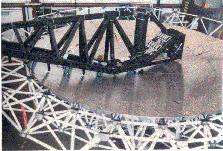
(5) Swing template |
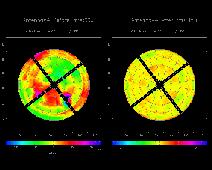
(1) Surface improvement of Antenna 4 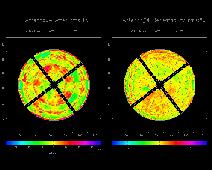
(2) Short-term (1-month) stability 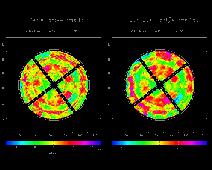
(3) Long-term (7-month) stability 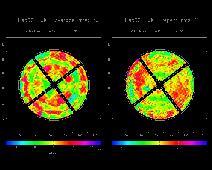
(4) Long-term average and repeatability |
tksridha@cfa.harvard.edu
